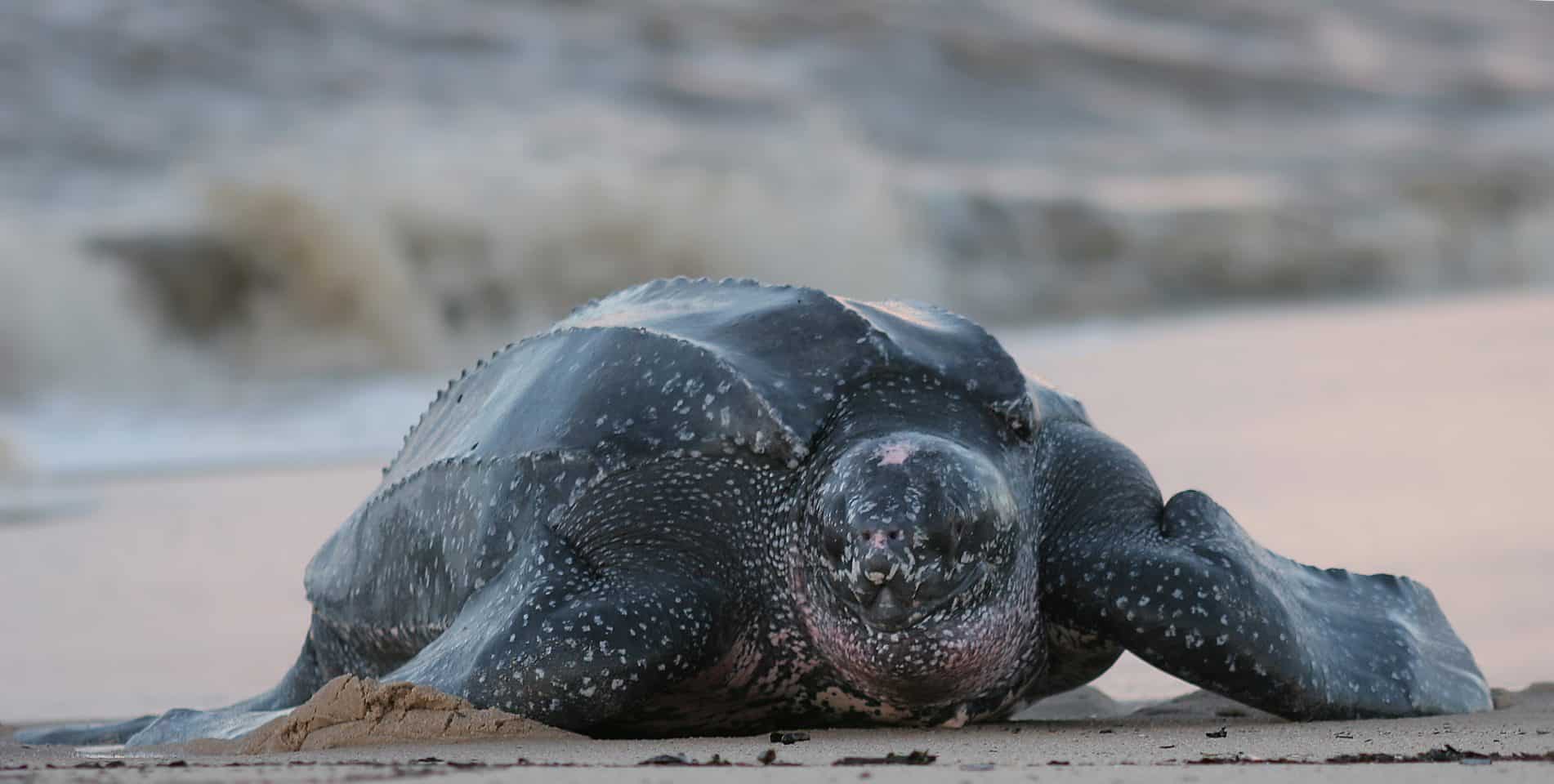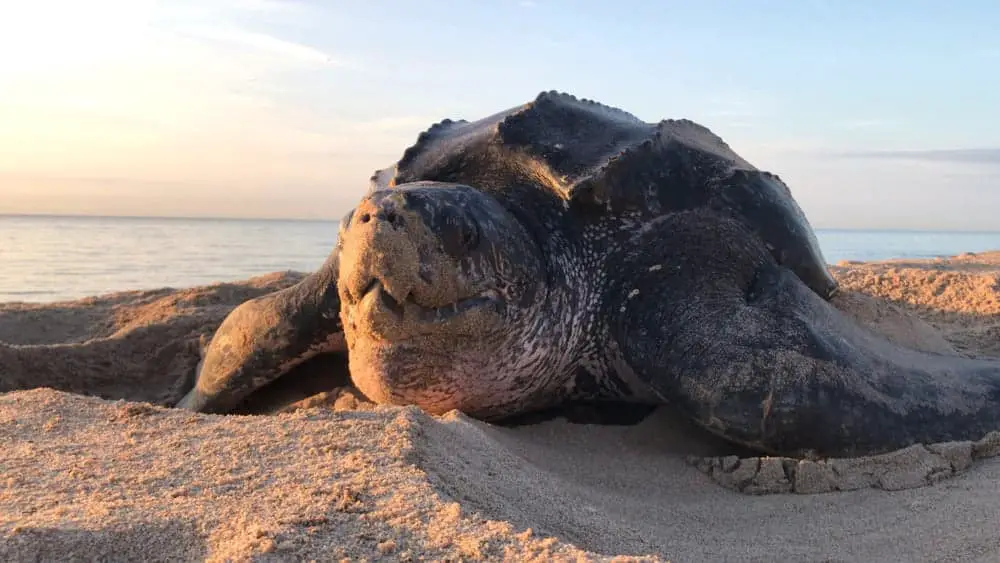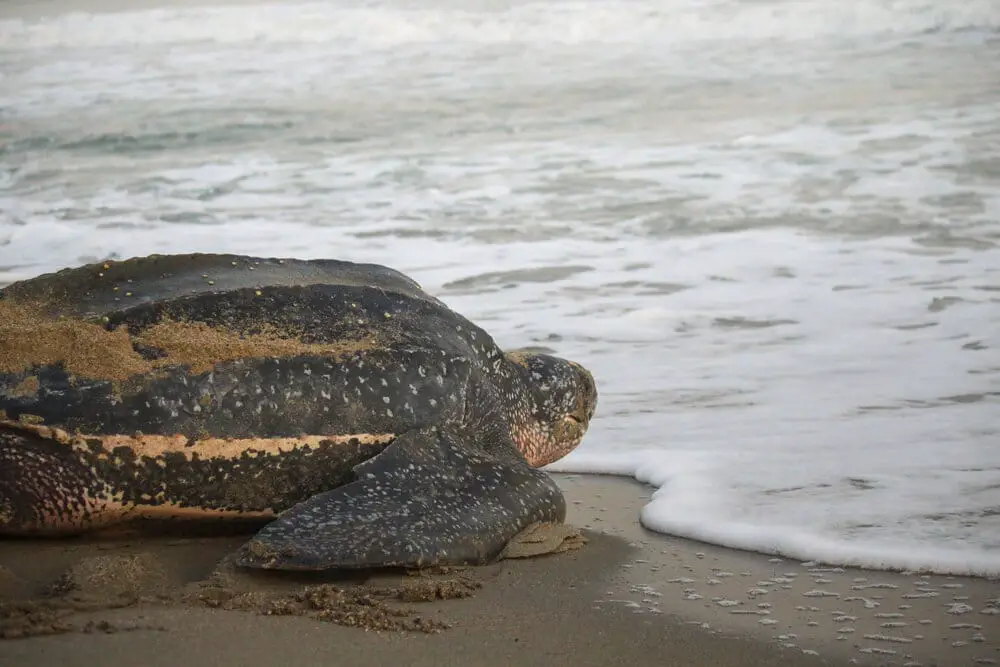What Is The Biggest Sea Turtle

Introduction
What Is The Biggest Sea Turtle: The world’s oceans are home to a diverse array of fascinating creatures, but among them, one truly stands out for its remarkable size and unique characteristics – the leatherback sea turtle (Dermochelys coriacea). In the vast expanse of Earth’s oceans, where life thrives in a multitude of forms, the leatherback sea turtle claims the title of the largest turtle and most colossal of all sea turtle species.
While most sea turtles are recognized for their captivating beauty and distinctive carapaces, the leatherback sets itself apart in numerous ways. Unlike its relatives, which boast a hard, bony shell, the leatherback’s carapace is remarkably soft and leathery, hence its name.
What truly astonishes marine enthusiasts and scientists alike is the leatherback’s astonishing size. These gentle giants can reach lengths of up to seven feet and weigh as much as 2,000 pounds or more. Their sheer bulk and robust physique are awe-inspiring, making them the true titans of the sea turtle world.
We will delve deeper into the world of the leatherback sea turtle, uncovering its remarkable biology, unique behaviors, and the critical conservation efforts required to protect this magnificent marine giant from the threats it faces in our ever-changing oceans. Join us on a journey to discover what truly makes the leatherback the biggest and most captivating sea turtle on our planet.

What is the largest sea turtle ever recorded?
Archelon
Archelon is an extinct marine turtle from the Late Cretaceous, and is the largest turtle ever to have been documented, with the biggest specimen measuring 4.6 m (15 ft) from head to tail and 2.2–3.2 t (2.4–3.5 short tons) in body mass. It is known only from the Pierre Shale and has one species, A. ischyros.
The largest sea turtle ever recorded is a remarkable specimen that showcased the astonishing size and grandeur of the leatherback sea turtle species. While individual sizes can vary, the largest confirmed leatherback on record measured an astounding 10.8 feet (3.3 meters) in length and weighed an incredible 2,019 pounds (918 kilograms). This colossal creature was discovered on a beach in Wales, United Kingdom, in 1988, leaving researchers and marine enthusiasts awestruck.
This record-breaking leatherback’s enormous dimensions highlight the exceptional nature of this species. Its massive size allows it to venture into the depths of the ocean, where it primarily feeds on jellyfish, using its size advantage to its benefit. Such an extraordinary example of the leatherback sea turtle reminds us of the incredible diversity and hidden wonders that lie beneath the surface of our oceans.
While this particular leatherback’s size may be unparalleled in recorded history, it serves as a symbol of the awe-inspiring nature of marine life and the vital importance of conservation efforts to protect these majestic creatures. The quest to learn more about these magnificent sea turtles and ensure their survival continues, as we work to safeguard the future of these gentle giants of the sea.
What is the biggest sea turtle alive today?
Leatherbacks
Leatherbacks are the largest sea turtle species living today. Adults can be more than 6 feet long and weigh up to 2,000 pounds! Leatherbacks are the only sea turtle species without a bony carapace.
The largest sea turtle species alive today is the leatherback sea turtle (Dermochelys coriacea). These magnificent creatures are renowned for their incredible size and unique physical characteristics. Adult leatherbacks can grow to an impressive length of up to 7 feet (2.13 meters) and weigh as much as 2,000 pounds (900 kilograms) or more.
What sets the leatherback apart from other sea turtles is its soft and leathery carapace, in contrast to the hard, bony shells of its relatives. This flexible shell enables the leatherback to withstand the intense pressures of deep-sea diving, allowing it to descend to depths exceeding 4,000 feet (1,200 meters) in search of its primary prey, jellyfish.
The size and strength of the leatherback make it an oceanic giant, and it holds a vital ecological role as a top predator that helps regulate jellyfish populations. However, like many marine species, leatherbacks face numerous threats, including habitat loss, pollution, entanglement in fishing gear, and climate change.
Protecting these magnificent creatures and their habitats is crucial to ensure the continued existence of the largest sea turtle on Earth. Conservation efforts, research, and international cooperation are essential to safeguard the leatherback sea turtle and preserve its place as the largest living sea turtle species.
What is the second largest sea turtle?
The green sea turtle is the second largest after the leatherback. They can weigh up to 500 lbs (225 kg) and reach four feet (1.2 m) in length.
The second largest sea turtle species in the world is the loggerhead sea turtle (Caretta caretta). While not as massive as the leatherback, loggerheads are still impressive in size and hold a significant place in the hierarchy of sea turtles. Adult loggerheads typically reach lengths of 3 to 4 feet (0.9 to 1.2 meters) and can weigh between 200 and 350 pounds (90 to 159 kilograms), although some individuals have been recorded at even larger sizes.
These turtles are known for their distinctive reddish-brown shells, or carapaces, which are characterized by a large head and powerful jaws that give them their name. Loggerhead sea turtles have a broad distribution, inhabiting various oceanic regions, including the Atlantic, Indian, and Pacific Oceans.
Loggerheads, like all sea turtle species, face numerous threats, including habitat destruction, pollution, entanglement in fishing gear, and climate change. Conservation efforts have been undertaken globally to protect loggerheads and their nesting sites, as these turtles are crucial to the balance of marine ecosystems.
Despite their impressive size, loggerhead sea turtles are a vulnerable species, and their conservation is vital to maintaining the biodiversity and health of our oceans. Efforts to protect these remarkable creatures and their habitats are essential to ensuring their continued existence.
Can turtles live up to 500 years?
Their lifespan can be 150 years or more. As with whales, sharks, and other species, it is often difficult to determine a turtle’s exact age. After all, researchers are not usually present when the animals are born. Some have estimated, however, that large turtles may be able to live 400 to 500 years!
While turtles are known for their long lifespans compared to many other animals, their maximum age is not nearly as extreme as 500 years. The oldest known turtles are typically tortoises rather than aquatic turtles and fall into the range of 100 to 200 years.
One of the most famous long-lived turtles is the Galápagos giant tortoise, with some individuals recorded to live over 150 years. Similarly, the Aldabra giant tortoise, native to the Aldabra Atoll in Seychelles, can have lifespans of up to 200 years.
In the case of aquatic turtles, the common snapping turtle and the alligator snapping turtle can live for several decades, with lifespans ranging from 20 to 70 years, depending on the species and environmental factors.
The idea of turtles living up to 500 years might be a misconception or confusion with other long-lived animals like certain species of whales, such as the bowhead whale, which can live over 200 years.
While turtles are known for their impressive longevity, they do not reach the extraordinary age of 500 years. Their typical lifespans vary by species and environmental conditions but generally fall within the range of decades to a couple of centuries.
Can sea turtles live 1000 years?
Sea turtles typically live between 30 and 50 years, with some documented cases of sea turtles living as long as 150 years. While we know that all sea turtle species have lengthy lifespans, the upper limit of their potential natural lifespan remains a mystery to scientists.
While sea turtles are indeed remarkable creatures with long lifespans compared to many other animals, their maximum age is not even remotely close to a millennium.
The lifespan of sea turtles varies among different species. The loggerhead and green sea turtles, for example, can live for several decades, with some individuals surviving up to 80 to 100 years under favorable conditions. The leatherback sea turtle, the largest of all sea turtles, typically has a shorter lifespan, often around 45 to 60 years.
The myth of sea turtles living for 1000 years likely stems from misconceptions or confusion with other long-lived marine creatures, such as certain species of whales. The bowhead whale, for instance, is known to live over 200 years, and the Greenland shark has been found to live for several centuries.
Sea turtles, while impressive in their own right, do not approach the extraordinary lifespans attributed to some other marine animals. Their lifespans are indeed remarkable but are still measured in decades and not in centuries, let alone a millennium.
How old is the longest sea turtle?
They are:
- Leatherback sea turtle (Dermochelys coriacea) 90.4 years.
- Loggerhead sea turtle (Caretta caretta) 62.8 years.
- Olive Ridley sea turtle (Lepidochelys olivacea) 54.3 years.
- Hawksbill sea turtle (Eretmochelys imbricata) 53.2 years.
- Flatback sea turtle (Natator depressus) 50.4 years.
The age of the longest-lived sea turtle is a matter of estimation rather than precise measurement. Sea turtles, like many wild animals, do not have their ages easily determined, as they lack the annual growth rings found in trees or the clear aging markers seen in some terrestrial animals.
The age of a sea turtle is typically inferred based on its size, reproductive maturity, and known growth rates. Among the sea turtle species, the giant leatherback sea turtle (Dermochelys coriacea) is known for its impressive size and longevity. These turtles can reach lengths of up to 7 feet and weigh over 2,000 pounds.
It’s believed that leatherback sea turtles can live for several decades, with some estimates suggesting they may reach up to 60-80 years of age under favorable conditions. However, there isn’t a definitive record of the absolute oldest leatherback, as accurately determining their age in the wild is challenging.
While we can estimate the age of sea turtles based on certain criteria, determining the age of the longest-lived sea turtle remains a matter of estimation and scientific inference rather than precise measurement. Their longevity, nonetheless, is a testament to their remarkable adaptability and resilience in the world’s oceans.
Are there protected areas for Leatherback Sea Turtles?
There are protected areas established specifically for the conservation of leatherback sea turtles (Dermochelys coriacea) around the world. These protected areas aim to safeguard critical nesting sites and foraging habitats for these endangered turtles, as well as to manage and mitigate various threats they face.
One notable example of such a protected area is the Leatherback Turtle National Wildlife Refuge in the United States, which includes beaches and waters off the coast of Florida and the U.S. Virgin Islands. This refuge is dedicated to the preservation of leatherback sea turtle nesting habitats, and it restricts activities that could disturb or harm the turtles or their nests.
In the Caribbean, countries like Trinidad and Tobago have established leatherback sea turtle conservation programs and protected areas, such as the Grand Riviere Beach and Matura Beach, where these turtles come ashore to lay their eggs.
International organizations like the WWF (World Wide Fund for Nature) and local conservation groups collaborate with governments to establish and maintain these protected areas. These efforts include monitoring nesting sites, implementing regulations to reduce human disturbances, protecting hatchlings, and conducting scientific research to better understand and protect leatherback sea turtles.
The establishment of protected areas plays a crucial role in ensuring the survival of these magnificent creatures by providing safe spaces for nesting and foraging, helping to reverse their declining populations, and contributing to the overall conservation of marine ecosystems.
How big can a Leatherback Sea Turtle get?
Leatherback sea turtles (Dermochelys coriacea) are the largest sea turtle species on Earth and can reach impressive sizes. These marine giants are renowned for their immense dimensions, making them truly remarkable creatures.
Adult leatherback sea turtles typically measure between 5 to 7 feet (1.5 to 2.1 meters) in length, from the tip of their nose to the end of their carapace (shell). Some exceptionally large individuals have been recorded at even greater lengths, pushing the upper limits of this range. Additionally, these turtles can weigh anywhere from 550 to 2,000 pounds (250 to 900 kilograms) or more.
What sets leatherbacks apart from other sea turtle species is their unique carapace, which is not hard and bony like that of their relatives. Instead, it is covered with a tough, leathery skin. This adaptation allows leatherbacks to dive to incredible depths, over 4,000 feet (1,200 meters), in search of their primary prey – jellyfish.
The immense size and strength of leatherback sea turtles reflect their status as the largest living sea turtles. These oceanic giants play a critical role in marine ecosystems, and their conservation is vital to maintaining the health and balance of our oceans.

Conclusion
The leatherback sea turtle, Dermochelys coriacea, emerges as a true marvel of the natural world. Its distinction as the largest sea turtle species is not merely a matter of size but a testament to the remarkable adaptations it has evolved to survive in the world’s oceans.
We’ve explored the unique features of the leatherback, from its soft and leathery carapace to its impressive dimensions that set it apart from all other sea turtles. Its ability to dive to astonishing depths, feeding on jellyfish, showcases its incredible resilience and ecological importance.
However, the leatherback’s survival is under threat. The perils of climate change, pollution, habitat loss, and accidental bycatch in fishing operations endanger this magnificent species. Conservation efforts are crucial to ensure the leatherback sea turtle’s continued existence, as its decline would not only be a loss in itself but also disrupt the delicate balance of marine ecosystems.
Our journey into the world of the biggest sea turtle has not only revealed the wonders of this species but also underscored the urgent need for global cooperation in safeguarding its future. Through education, research, and conservation initiatives, we can aspire to preserve the legacy of the leatherback sea turtle and ensure that it remains a symbol of the awe-inspiring diversity of life in our oceans.



